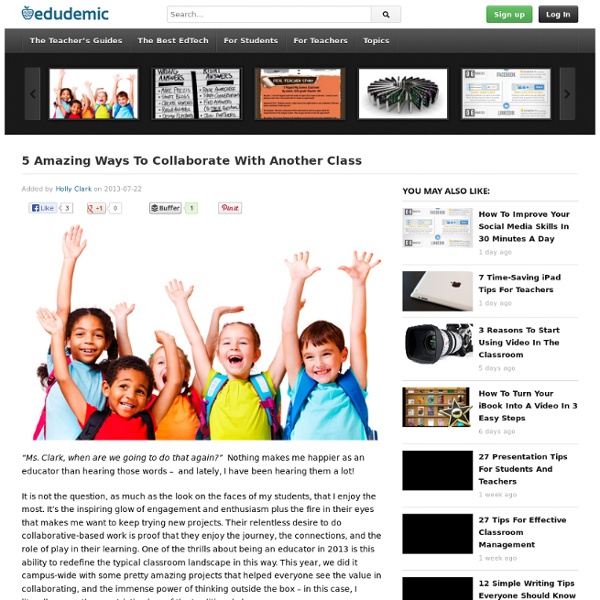5 Amazing Ways To Collaborate With Another Class

6 Ways Students Can Collaborate With iPads
The following post is written by Greg Kulowiec of EdTechTeacher . Join EdTechTeacher at the iPad Summit in Atlanta on April 10-12. The app store is loaded with options that allow students to create content on their iPads. However, collaboration between students is often a critical component of any classroom activity or project and increasingly there are options available that allow for collaborative efforts across iPads. Below are six ways to support collaboration between student iPads that cover the spectrum of creation options that range from text to digital storytelling to video creation. Explain Everything ($2.99) A flexible and powerful screen casting option, students and teachers can collaborate on screencasts by exporting Explain Everything project files from an iPad. Currently, .XPL (Explain Everything) files can be exported via Dropbox, Evernote, Box, WebDAV and email and the next update of Explain Everything will support .XPL exports to Google Drive. Google Drive (Free) Diigo
5 Keys to Successful Student Collaborations
As you know, group work can give teachers headaches and students nightmares. If set up poorly, collaborative projects often result in one person doing all of the work, while others contribute minimally or actually disrupt. Arguments, inefficiency, mess, and chaos follow closely. When set up well, though, group work taps into the power of collaboration. Here are 5 keys to setting up successful student collaborations. Define group success. We live in a web of collaboration. We want to hear from you! Click to Print
Hoadley's 3 Laws Of Education Technology
I was just alerted to a new presentation all about the proper role of education technology. Seems quite a familiar theme like what I outlined in this post after yesterday’s Apple WWDC keynote . Basically that technology is a tool and that it’s all about what you do with it, not all the bells and whistles you see in an advertisement. Law #1: It’s not the technology. Since there’s not really a description about each law, I’m going to make a best-guess here. Law #2: It’s not what the technology makes possible. Again, this is just my interpretation and ideas about the second law. Law #3: Pay attention to the trends in learning, not in technology. I try to do this with Edudemic every day.
4 Different Visual Guides To Bloom's Taxonomy
I recently received a question from a reader who wasn’t clear about what exactly Bloom’s taxonomy is. It got me thinking that perhaps not everyone is a Bloom’s taxonomy expert, and a little bit of a refresher might be helpful. In later posts, we’ll look at a variety of iterations and interpretations of the traditional Bloom’s graphic, along with apps and tools that address Bloom’s objectives in our modern classrooms. In a nutshell, Bloom’s taxonomy is a grouping of educational objectives that first came about in 1956 in an attempt to classify educational objectives. The original looked like this: Bloom identified four principles that guided the development of the taxonomy. Based on student behaviorsShow logical relationships among the categoriesReflect the best current understanding of psychological processesDescribe rather than impose value judgments As with everything in life, times changed/things progressed/humans evolved, and another version was created in 2000.
Related:
Related:



